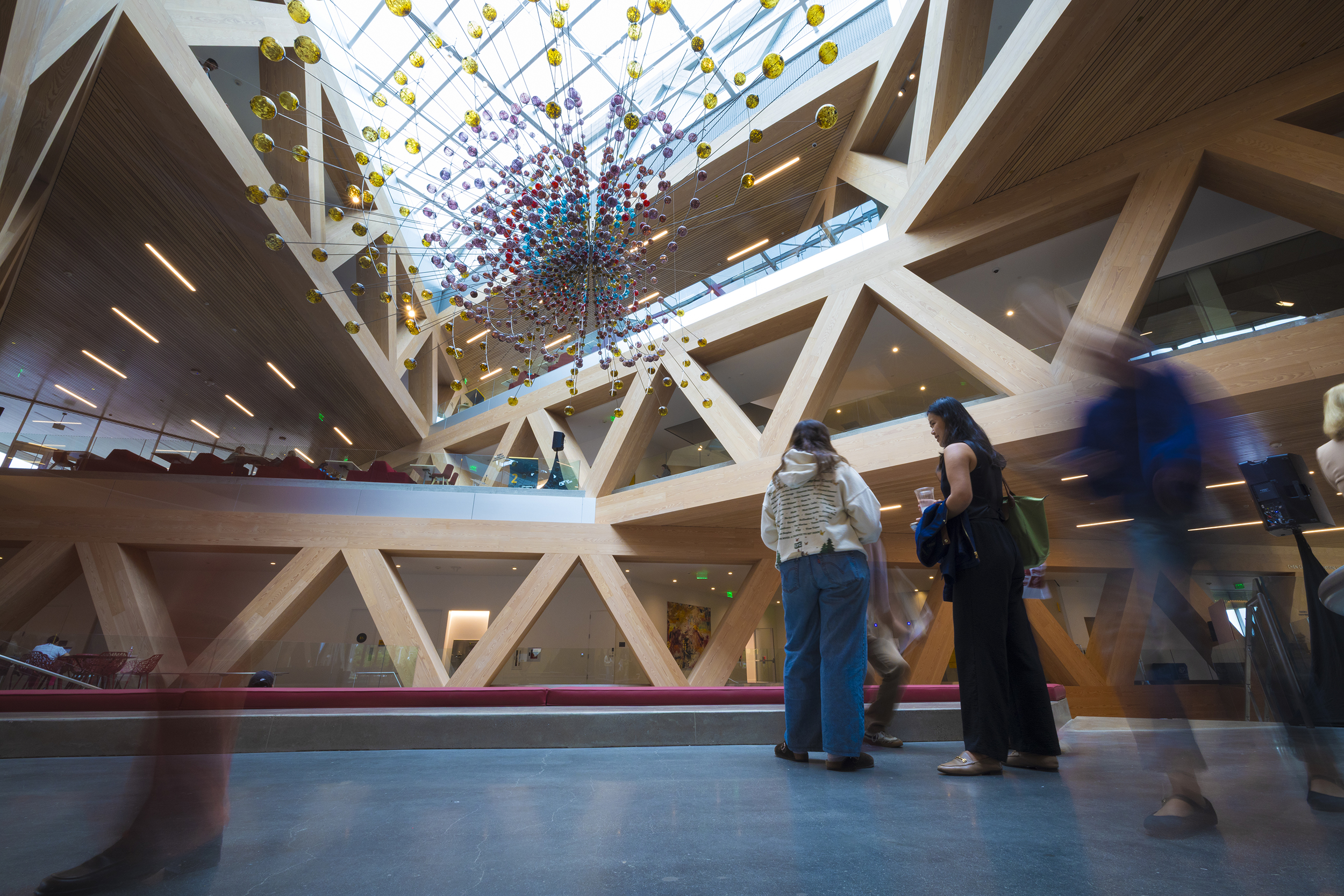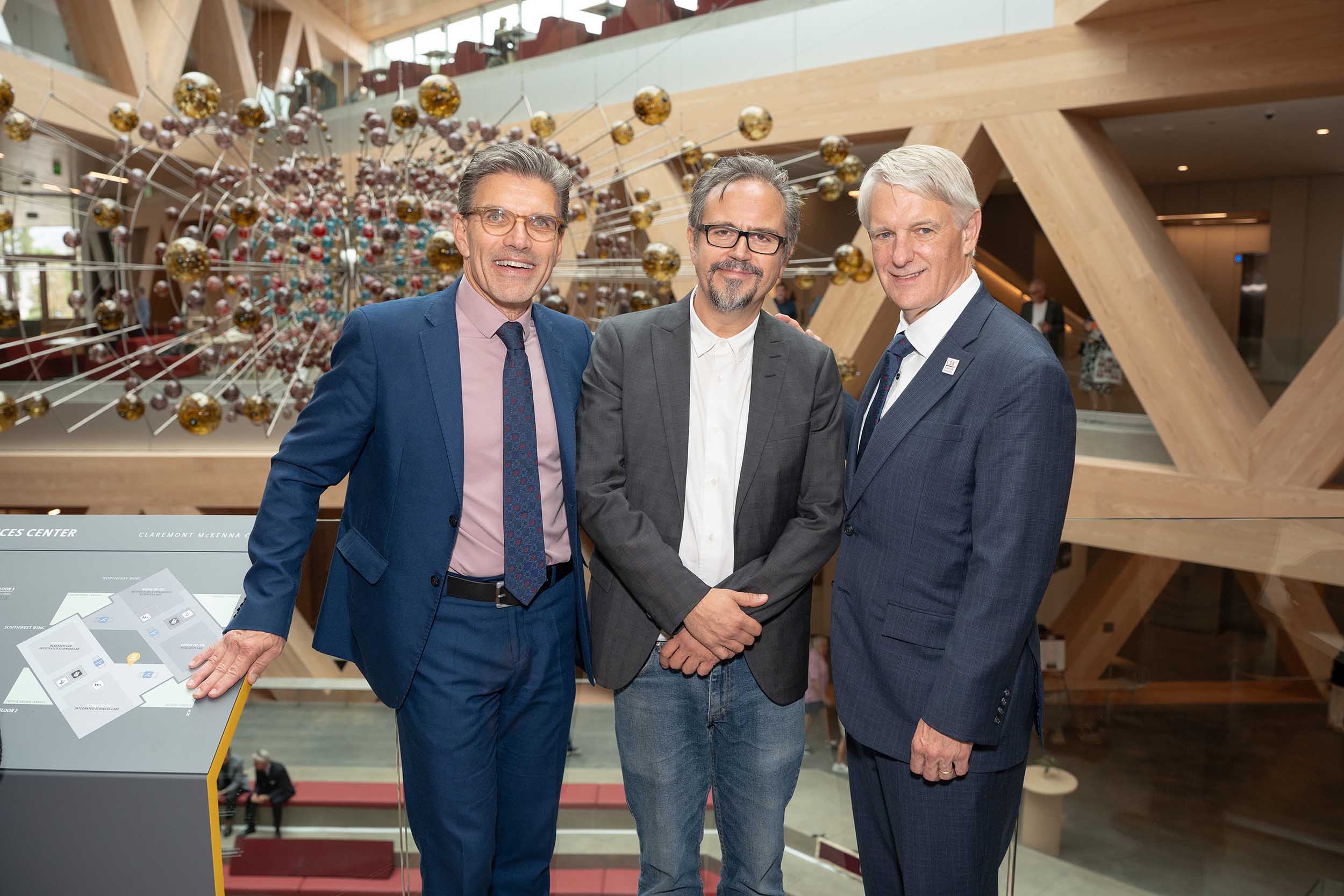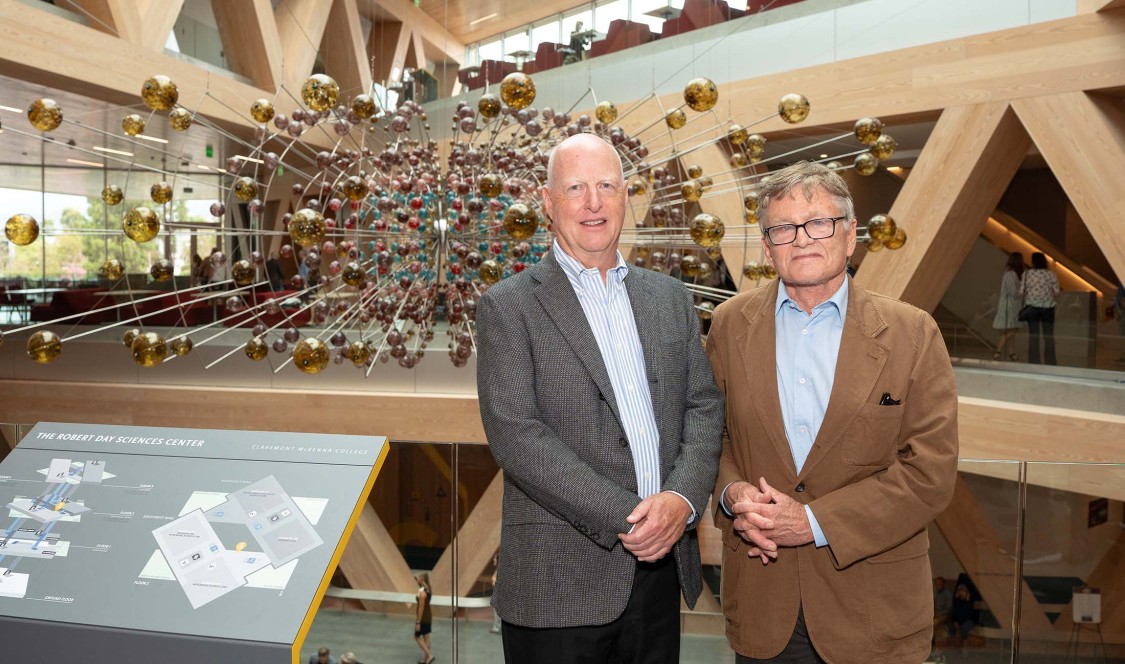The power of Damián Ortega’s Magnetic Field, one of CMC’s newest public art installations, resonates throughout the Robert Day Sciences Center, where it hangs high above the atrium.
At the sculpture’s official dedication on Sept. 26, as part of the larger community-wide celebration of the RDSC, the audience gasped in collective amazement when CMC Life Trustee Christopher Walker ’69 described the Herculean effort to hoist—and then suspend—the 3,000-pound work 30 feet into the air.
Comprised of 18 rings of stainless-steel round bar, a stainless-steel sphere, and 1,476 colorful glass spheres of various sizes, the sculpture depicts a diagram of the Earth’s magnetic field—a shield that protects the planet from solar storms and its potent radiation, thus enabling life to thrive on our planet.
The dramatic artwork is among the latest additions to the College’s Walker Collection of Public Art, along with H£Rñ§ñ0H§L by Anicka Yi and Jaume Plensa’s To JW Goethe (variant VIII), which are on display in the RDSC’s Quantum Library and the Agora, respectively.

“Some might be surprised that at a dedication of a state-of-the-art science center we are also celebrating public art on campus,” said CMC Trustee Shaw Wagener ’81, who is a member of the CMC Art Advisory Panel. “After all, science doesn’t necessarily conjure up the thought of great art, but all of us gathered here today know differently. Great science comes from inspiration, and few things inspire more than great art.”
Since its launch in 2012, the Public Art Program has enriched CMC’s culture with works by renowned contemporary artists: Carol Bove, Chris Burden, Ellsworth Kelly, Jeppe Hein, Mary Weatherford, and Pae White. In 2025, CMC’s Board of Trustees honored Walker by naming the Walker Public Art Collection in recognition of his contributions. Through his guidance, the CMC campus has swiftly transformed into a destination for world-class works of art.
Walker described himself as feeling surprised when the Board announced the recognition. “This is the highest honor I’ve received at CMC. It’s important to me that I started a program that is now a contemporary art collection that—like the CMC adage—fights above our weight class,” he said.
Acknowledging the team who met the challenge of installing Magnetic Field, Walker cited the efforts of Andres Ramirez (CMC Assistant Vice President for Campus Planning and Capital Projects); Matt Bibbens ’92 (CMC Vice President for Campus Planning and Capital Projects); Michelle Barlow (CMC Assistant Vice President, Facilities and Campus Services); Kimberly Shiring (then-CMC Director of Public Art); KPRS Construction Services; structural engineering firm, Saiful Bouquet; and architectural firm, BIG-Bjarke Ingels Group.
Magnetic Field is the latest example of Walker’s efforts to bring revolutionary public art to campus.
“CMC’s public art program focuses on activating shared spaces for the campus community into venues for connection and reflection,” said Shiring, who has been deeply involved with the public art program for more than a decade, served as Director of the Public Art Program for more than five years, and currently supports the program in a consultancy role.

“In the spirit of The Open Academy, the Walker Collection invites a variety of experiences with campus artworks with the intention that Magnetic Field continues a dialogue on creativity and differing interpretations,” said Shiring, who shepherded CMC’s large-scale public art projects, including Magnetic Field.
To foster dialogue and understanding with Ortega, Walker traveled to Mexico City twice to meet with the artist in his studio.
“He has achieved folk hero status in Mexico,” Walker said. “He’s a great intellectual who is also great fun and a wonderful collaborator with the College’s public art program. This work uses everyday objects and is suspended to invite the viewer into a visual, reflective, and cosmic experience, all while bringing social history into play.”
Ortega shared how moved he was to join the RDSC celebration. “Being part of such a big and integral, meaningful project has been a privilege,” he said, before thanking the team of artisans and structural engineers who brought his vision to fruition.
“One of the most exciting parts of the project was seeing how people from many different countries were involved,” Ortega said, noting how his materials and collaborations were “international in character,” from Canada, Poland, Germany, Denmark, and Mexico. “This shows the duality and diversity that shape the building,” he added.
“This project was possible thanks to dialogue, collaboration, and shared energy.”
The artwork is available for viewing during normal RDSC operating hours.

